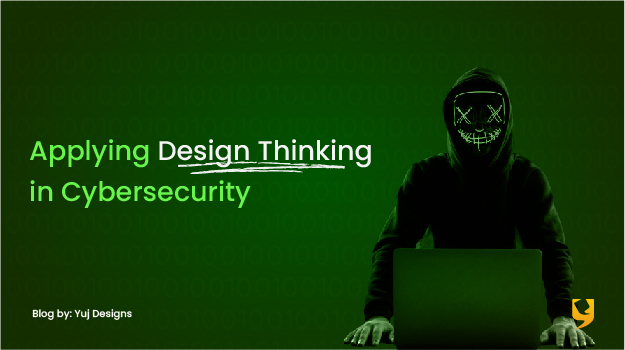
The first image that pops in front of our eyes when thinking about cybercrime is a dark ominous hooded figure. A threat to our digital data and our digitally connected lives. A lot of this visual has its roots in movies and tv series that we watch. This further proves ignorance about this domain. Design thinking on the other hand, has been around for quite a while now. Though, application of design thinking in cybersecurity is an upcoming trend these days. UX design studios were the first few ambassadors of design thinking.
What is Design Thinking?
Today, for a business to be successful, it is not enough to just sell products/ services. Designing an exclusive experience for the customers differentiates the brand from the competition in the market. The broader takeaway here being – Empathy. Design thinking is all about solving problems with the customers at the centre. Empathy is the foundation of design thinking.
Principles of Design Thinking
The principles of design thinking can be articulated in the manner mentioned below –
1. Empathize
Try to see their world through their eyes. Empathize with the users to gain insights into what they need, what improvements they wish for, their behavior pattern, way of thinking, how they react. And the reason, or the drive behind the decisions they make when interacting with products in a real-world scenario.
Any management model keeps the users and customers at the centre of their problem solving. Design thinking takes it a notch higher. Design thinking in cybersecurity domain puts the user’s technical and functional needs in focus. At the same time, design thinking also considers their behavior patterns, preferences and beliefs. When working towards a solution it is important to consider worldly scenarios and not only ideal situations. Considering the happy paths as well as the extreme case scenarios are essential. It is crucial to know that almost all of the security breaches happen because of negligence of user behavior.
Application of design thinking in cybersecurity naturally proves to be a fit. Design thinking is about designing solutions considering the human behavior patterns. Not the other way around. Assuming every user to adhere to the security controls without making an error at all times, would prove to be an ineffective solution.
It is essential for cybersecurity professionals to have empathy towards users of the systems who are at the facing end of the attacks. It is important to understand what makes the users tick and offer products that are easy to use and secure. Good cybersecurity is about people and technology working together. With this approach we can design better training, culture and awareness programmes for the users. It can also yield good results on attracting more and diversified talent to the domain.
2. Ideate
Gather the data about users and the domain. Identify the problems and generate a wide variety of potential possibilities, answers and solutions that would help the users.
Focus on the Solution. Avoid using analytical problem solving methods. This approach is all about defining the technical problem, considering the consequences to build a technical solution. This creates a stat of reactivity. Design thinking on the other hand, encourages to look beyond day-to-day technical problems. This helps in developing a long-term, visionary strategy. This is an important approach towards building solutions that retain the overall harmony of the product.
When applying design thinking in cybersecurity, it is important not to forget the power of data. Data volumes are growing in cybersecurity. The domain requires efficient data analytics, integration tools and data synthesis. An efficient data synthesis prevents additional costs and damages. And enables informed design decisions.
3. Implementation
It is highly essential to understand the customer behavior in the domain of cybersecurity specifically. The customers once accustomed to a company’s products often prefer the same company for a new requirement. The products and or services in cybersecurity are of providers of high value for the end-user. The end-user places utmost trust in the company while buying in.
Being a high-risk domain, the loyalty of the customers may become challenging to gain. Should you choose to see the other side of the story – once you make the potential customer buy your product, the customer will be loyal to your business. This is the reason why cybersecurity has always faced the issues of expanding the user base, and providing experiences to the users that can change their minds.
This is the reason why creating prototypes, testing it and implementing the solutions is an integral part of design thinking. In this approach, building and testing is valued over thinking that cannot be put into action.
Solving real-world problems for users can only be validated by actually putting those into action and testing for impact. Even if design thinking encourages long-term problem solving, it is about practicing small and fast. To build smaller prototypes, iterate quickly, refine upon what is not working and implement. This is a continuous loop of an effort.
Benefits of Design Thinking for Cybersecurity
Design thinking revolves around a central idea – building solutions that users will use and they will benefit from.
31.9% of IT security professionals ignore threat alerts.
Modern day security providers are facing a big challenge worldwide. A recent study found out a recurring pattern in data breaches. The alerts and alarms go off, but due to the large number of alerts being triggered every now and then, the alerts are usually ignored. This itself is alert fatigue. Applying design thinking to solve these problems can definitely help.
After every other cyber attack, studies have found out that 40% of the indirect costs of an attack result in loss of business.
The events following these cyber attacks, translate to loss of customer loyalty. It is a well known phenomenon that gaining the trust of new customers in the domain of cybersecurity is very difficult.
Applying design thinking in cybersecurity will enhance the business offerings tremendously. It will ensure that the users adopt the provided solutions more organically. Overcoming these and many more challenges by innovating solutions, will always be the biggest upside of implementing design thinking in cybersecurity.
Amplify your brand presence with the best UX design studio that truly aligns your needs with those of your consumers! Get in touch with us at YUJ Designs, today!






